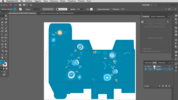Ambient marketing is a kind of creative marketing, unconventional, and contextualised, aiming to catch the attention of observers, by using the surprise effect. This kind of commercial action uses and transforms elements of the surrounding space, making them an essential part of the brand advertising strategy.
Urban furnishing elements, stairs, public toilet, vehicles, squares, pedestrian areas, etc…: any element placed out-of-home may turn into the perfect protagonist to convey the message of these promotional campaigns.
A successful ambient marketing campaign surely needs a strong creativity and the ability to choose the right – and unsuspected – places, with high people flow and mainly visited by the reference target. In addition, it is really important the generated surprise effect: to amaze and touch people guarantees a great effect on memory, because emotions are better remembered.
Conveying direct messages by using unusual ways can be more effective than using traditional advertising media. In fact, the unexpected, even creative, allows overcoming barriers and filters coming from media blitz we put every day through. It is all about a kind of compelling advertising, that let people get curious because it will be experienced not as an imposition by the audience, who will be then more receptive.
Ambient marketing is based on the same guerrilla marketing principles that, unlike the first one, stands out on using more “aggressive” media and tools. It is about real surprise attacks and ambushes, typical of guerrilla (hence the name), that require direct interactions by the audience. Closer and more compelling actions with a strong energy and imagination.
Both the methods, falling within emotional marketing, are cheaper than other advertising campaigns, because they allow reaching great visibility with low investment. The audience is the promoter and, thanks to word of mouth, will favourite its virality.
The 10 guerrilla and ambient marketing adv campaigns selected use the packaging to achieve the desired surprise effect and simply explain the immediate philosophy behind the above-described strategies.













